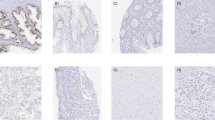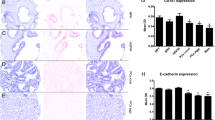Abstract
New gene expressed in prostate (NGEP) is a newly diagnosed prostate-specific gene that is expressed only in normal prostate and prostate cancer cells. Discovery of tissue-specific markers may promote the development of novel targets for immunotherapy of prostate cancer. In the present study, the staining pattern and clinical significance of NGEP were evaluated in a series of prostate tissues composed of 123 prostate cancer, 19 high-grade prostatic intraepithelial neoplasia and 44 samples of benign prostate tissue included in tissue microarrays using immunohistochemistry. Our study demonstrated that NGEP localized mainly in the apical and lateral membranes and was also partially distributed in the cytoplasm of epithelial cells of normal prostate tissue. All of the examined prostate tissues expressed NGEP with a variety of intensities; the level of expression was significantly more in the benign prostate tissues compared to malignant prostate samples (P value <0.001). Among prostate adenocarcinoma samples, a significant and inverse correlation was observed between the intensity of NGEP expression and increased Gleason score (P = 0.007). Taken together, we found that NGEP protein is widely expressed in low-grade to high-grade prostate adenocarcinomas as well as benign prostate tissues, and the intensity of expression is inversely proportional to the level of malignancy. NGEP could be an attractive target for immune-based therapy of prostate cancer patients as an alternative to the conventional therapies particularly in indolent patients.



Similar content being viewed by others
Abbreviations
- Ano 7:
-
Anoctamin 7
- BPH:
-
Benign prostatic hyperplasia
- Epe:
-
Extraprostatic extension
- ESTs:
-
Expressed sequence tags
- FDA:
-
Food and drug administration
- HPIN:
-
High-grade prostatic intraepithelial neoplasia
- IHC:
-
Immunohistochemistry
- ISH:
-
In situ hybridization
- MAb:
-
Monoclonal antibody
- NGEP:
-
New gene expressed in prostate
- PBMC:
-
Peripheral blood mononuclear cell
- PCa:
-
Prostate cancer
- PSA:
-
Prostate-specific antigen
- PSMA:
-
Prostate-specific membrane antigen
- PSCA:
-
Prostate stem cell antigen
- TMA:
-
Tissue macroarray
- TRICOM:
-
Triad of costimulatory molecules (B7.1, ICAM-1, LFA-3)
References
Vainio P, Lehtinen L, Mirtti T, Hilvo M, Seppanen-Laakso T, Virtanen J, Sankila A, Nordling S, Lundin J, Rannikko A, Oresic M, Kallioniemi O, Iljin K (2011) Phospholipase PLA2G7, associated with aggressive prostate cancer, promotes prostate cancer cell migration and invasion and is inhibited by statins. Oncotarget 2:1176–1190
Ferlay J, Autier P, Boniol M, Heanue M, Colombet M, Colombet M, Boyle P (2007) Estimates of the cancer incidence and mortality in Europe in 2006. Ann Oncol 18:581–592
Shanmugam A, Suriano R, Chaudhuri D, Rajoria S, George A, Mittelman A, Tiwari RK (2011) Identification of PSA peptide mimotopes using phage display peptide library. Peptides 32:1097–1102
Crawford ED, Rosenblum M, Ziada AM, Lange PH (1999) Hormone refractory prostate cancer. Urology 54:1–7
Gulley JL, Arlen PM, Bastian A, Morin S, Marte J, Beetham P, Tsang KY, Yokokawa J, Hodge JW, Menard C, Camphausen K, Coleman CN, Sullivan F, Steinberg SM, Schlom J, Dahut W (2005) Combining a recombinant cancer vaccine with standard definitive radiotherapy in patients with localized prostate cancer. Clin Cancer Res 11:3353–3362
Karnes RJ, Whelan CM, Kwon ED (2006) Immunotherapy for prostate cancer. Curr Pharm Des 12:807–817
Lechleider RJ, Arlen PM, Tsang KY, Steinberg SM, Yokokawa J, Cereda V, Camphausen K, Schlom J, Dahut WL, Gulley JL (2008) Safety and immunologic response of a viral vaccine to prostate-specific antigen in combination with radiation therapy when metronomic-dose interleukin 2 is used as an adjuvant. Clin Cancer Res 14:5284–5291
Nesslinger NJ, Ng A, Tsang KY, Ferrara T, Schlom J, Gulley JL, Nelson BH (2010) A viral vaccine encoding prostate-specific antigen induces antigen spreading to a common set of self-proteins in prostate cancer patients. Clin Cancer Res 16:4046–4056
Harada M, Noguchi M, Itoh K (2003) Target molecules in specific immunotherapy against prostate cancer. Int J Clin Oncol 8:193–199
Slovin SF (2005) Targeting novel antigens for prostate cancer treatment: focus on prostate-specific membrane antigen. Expert Opin Ther Targets 9:561–570
Arlen PM, Gulley JL, Tsang KY, Schlom J (2003) Strategies for the development of PSA-based vaccines for the treatment of advanced prostate cancer. Expert Rev Vaccines 2:483–493
Israeli RS, Powell CT, Corr JG, Fair WR, Heston WD (1994) Expression of the prostate-specific membrane antigen. Cancer Res 54:1807–1811
Reiter RE, Gu Z, Watabe T, Thomas G, Szigeti K, Davis E, Wahl M, Nisitani S, Yamashiro J, Le Beau MM, Loda M, Witte ON (1998) Prostate stem cell antigen: a cell surface marker overexpressed in prostate cancer. Proc Natl Acad Sci U S A 95:1735–1740
Carter RE, Feldman AR, Coyle JT (1996) Prostate-specific membrane antigen is a hydrolase with substrate and pharmacologic characteristics of a neuropeptidase. Proc Natl Acad Sci USA 93:749–753
Yang WB, Cai F, Cheng CT, Cao G, Qing ZY (2009) Role of prostate stem cell antigen in human pancreatic carcinoma: a tissue microarray-based study. Nan Fang Yi Ke Da Xue Xue Bao 29:2135–2137
Bera TK, Das S, Maeda H, Beers R, Wolfgang CD, Kumar V, Hahn Y, Lee B, Pastan I (2004) NGEP, a gene encoding a membrane protein detected only in prostate cancer and normal prostate. Proc Natl Acad Sci U S A 101:3059–3064
Duran C, Qu Z, Osunkoya AO, Cui Y, Hartzell HC (2012) ANOs 3–7 in the anoctamin/Tmem16 Cl− channel family are intracellular proteins. Am J Physiol Cell Physiol 302:C482–C493
Hartzell HC, Yu K, Xiao Q, Chien LT, Qu Z (2009) Anoctamin/TMEM16 family members are Ca2+-activated Cl− channels. J Physiol 587:2127–2139
Galindo BE, Vacquier VD (2005) Phylogeny of the TMEM16 protein family: some members are overexpressed in cancer. Int J Mol Med 16:919–924
Moyer BD, Hevezi P, Gao N, Lu M, Kalabat D, Soto H, Echeverri F, Laita B, Yeh SA, Zoller M, Zlotnik A (2009) Expression of genes encoding multi-transmembrane proteins in specific primate taste cell populations. PLoS ONE 4:e7682
Das S, Hahn Y, Nagata S, Willingham MC, Bera TK, Lee B, Pastan I (2007) NGEP, a prostate-specific plasma membrane protein that promotes the association of LNCaP cells. Cancer Res 67:1594–1601
Das S, Hahn Y, Walker DA, Nagata S, Willingham MC, Peehl DM, Bera TK, Lee B, Pastan I (2008) Topology of NGEP, a prostate-specific cell:cell junction protein widely expressed in many cancers of different grade level. Cancer Res 68:6306–6312
Kantoff PW, Higano CS, Shore ND, Berger ER, Small EJ, Penson DF, Redfern CH, Ferrari AC, Dreicer R, Sims RB, Xu Y, Frohlich MW, Schellhammer PF (2010) Sipuleucel-T immunotherapy for castration-resistant prostate cancer. N Engl J Med 363:411–422
Zhou G, Levitsky H (2012) Towards curative cancer immunotherapy: overcoming posttherapy tumor escape. Clin Dev Immunol 2012:124187
Drake CG (2010) Prostate cancer as a model for tumour immunotherapy. Nat Rev Immunol 10:580–593
Arlen PM, Kaufman HL, DiPaola RS (2005) Pox viral vaccine approaches. Semin Oncol 32:549–555
Gerritsen WR (2012) The evolving role of immunotherapy in prostate cancer. Ann Oncol 23(Suppl 8):viii22–viii27
Cereda V, Poole DJ, Palena C, Das S, Bera TK, Remondo C, Gulley JL, Arlen PM, Yokokawa J, Pastan I, Schlom J, Tsang KY (2010) New gene expressed in prostate: a potential target for T cell-mediated prostate cancer immunotherapy. Cancer Immunol Immunother 59:63–71
Epstein JI, Allsbrook WC Jr, Amin MB, Egevad LL (2005) The 2005 International Society of Urological Pathology (ISUP) consensus conference on Gleason grading of prostatic carcinoma. Am J Surg Pathol 29:1228–1242
Pierorazio PM, Walsh PC, Partin AW, Epstein JI (2013) Prognostic Gleason grade grouping: data based on the modified Gleason scoring system. BJU Int 111:753–760
Ro YK, Lee S, Jeong CW, Hong SK, Byun SS, Lee SE (2012) Biochemical recurrence in Gleason score 7 prostate cancer in Korean men: significance of the primary Gleason grade. Korean J Urol 53:826–829
Cheng L, Montironi R, Bostwick DG, Lopez-Beltran A, Berney DM (2012) Staging of prostate cancer. Histopathology 60:87–117
Madjd Z, Karimi A, Molanae S, Asadi-Lari M (2011) BRCA1 protein expression level and CD44(+) phenotype in breast cancer patients. Cell J 13:155–162
Mehrazma M, Madjd Z, Kalantari E, Panahi M, Hendi A, Shariftabrizi A (2012) Expression of stem cell markers, CD133 and CD44, in pediatric solid tumors: a study using tissue microarray. Fetal Pediatr Pathol 32:192–204
Kononen J, Bubendorf L, Kallioniemi A, Barlund M, Schraml P, Leighton S, Torhorst J, Mihatsch MJ, Sauter G, Kallioniemi OP (1998) Tissue microarrays for high-throughput molecular profiling of tumor specimens. Nat Med 4:844–847
McCarty KS Jr, Miller LS, Cox EB, Konrath J, McCarty KS Sr (1985) Estrogen receptor analyses. Correlation of biochemical and immunohistochemical methods using monoclonal antireceptor antibodies. Arch Pathol Lab Med 109:716–721
Reichert JM, Rosensweig CJ, Faden LB, Dewitz MC (2005) Monoclonal antibody successes in the clinic. Nat Biotechnol 23:1073–1078
Pastan I, Hassan R, FitzGerald DJ, Kreitman RJ (2007) Immunotoxin treatment of cancer. Annu Rev Med 58:221–237
Mhawech-Fauceglia P, Zhang S, Terracciano L, Sauter G, Chadhuri A, Herrmann FR, Penetrante R (2007) Prostate-specific membrane antigen (PSMA) protein expression in normal and neoplastic tissues and its sensitivity and specificity in prostate adenocarcinoma: an immunohistochemical study using multiple tumour tissue microarray technique. Histopathology 50:472–483
Bahrenberg G, Brauers A, Joost HG, Jakse G (2000) Reduced expression of PSCA, a member of the LY-6 family of cell surface antigens, in bladder, esophagus, and stomach tumors. Biochem Biophys Res Commun 275:783–788
Koh YT, Gray A, Higgins SA, Hubby B, Kast WM (2009) Androgen ablation augments prostate cancer vaccine immunogenicity only when applied after immunization. Prostate 69:571–584
Ragde H, Cavanagh WA, Tjoa BA (2004) Dendritic cell based vaccines: progress in immunotherapy studies for prostate cancer. J Urol 172:2532–2538
Acknowledgments
This study was conducted as a research project and supported by a grant from Tehran University of Medical Sciences (Grant #13330).
Conflict of interest
The authors declare that they have no conflict of interest.
Author information
Authors and Affiliations
Corresponding author
Rights and permissions
About this article
Cite this article
Mohsenzadegan, M., Madjd, Z., Asgari, M. et al. Reduced expression of NGEP is associated with high-grade prostate cancers: a tissue microarray analysis. Cancer Immunol Immunother 62, 1609–1618 (2013). https://doi.org/10.1007/s00262-013-1463-1
Received:
Accepted:
Published:
Issue Date:
DOI: https://doi.org/10.1007/s00262-013-1463-1




